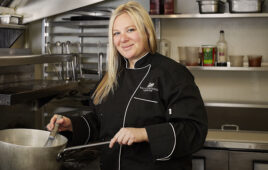For Colby Newman, Executive Chef of Amarillo (Texas) Country Club, cooking for a Field to Fork dinner allowed him to showcase local products and form better relationships with farmers.
When I received an email from the Texas Corn Producers asking me to be the chef for a Field to Fork dinner—even though it was being held on the last day of the only vacation that my wife and I take every year—I couldn’t turn it down. After a year of planning, the original chef had to back out due to a job change. This left me three weeks (including my one week of vacation) to build a menu from scratch.
The goal of the event, which took place 70 miles from Amarillo (Texas) in Sherman County in a corn field at the Early Settlers Farm, was to bring state legislators and other influencers in the local food industry together with the farmers who actually grow and produce some of our Texas crops. The dinner gave those who attended a better idea of what it takes to actually get an ingredient from the field to the plate. My job was to use specific local products and make them shine.They already had a list of products they wanted me to incorporate, such as Texas Gulf shrimp, beef (obviously, this is Texas), pork, sorghum, goat cheese, sunflower, peaches, corn, tomatoes, okra, and other various garden vegetables. Most of the food coming from the Panhandle, even the beef, which was processed just 20 miles away.
The previous chef had a year to prepare. I had only a fraction of that but I was not concerned about the execution of the dishes because being a chef at a country club has pushed me to think on my feet, be organized, and plan ahead. Rather than having elaborate dishes, I wanted to use technique and skill along with a progressive and modern twist to showcase the local ingredients.My Sous Chef Jeremy and I, along with my supportive, non-chef wife, (who always offers her assistance with plating), had to cook in a vacant farmhouse that didn’t even have a set-up kitchen until a day before the event. As a club chef you adapt to your surroundings. You’re not always going to have a top of the line kitchen. So, with a couple of refrigerators, a grill, and the tiniest gas stove ever made, we were able to produce four hors d’oeuvres and three courses for sixty people to enjoy while sitting outside next to the corn field.
I won’t go into detail about every dish we cooked, but for each dish I made sure to incorporate at least two local ingredients. It was important to me to not just showcase only one local ingredient in each dish. I wanted the diners to see how the flavors in one component help bring out the flavors in another, and vice versa. I was asked to use quail, watermelon, and sorghum in some way, so for one of the hors d’oeuvres I did a sorghum glazed quail leg with blueberry barbeque sauce and a watermelon relish.
While the quail was good, my favorite hors d’oeuvre was the one that I decided to use peach and pork belly as the local ingredients. We did a peach and pork belly skewer with a peach scallion puree and a grilled scallion chimichurri. It was a simple dish, but I loved how it had an East-meets-West vibe and it farm to table.
When you’re in charge of so many things and always making sure the dining at your club is the best for its members, it can be difficult to find the time to cook for other events like this. But I’m grateful for the opportunity I had to cook for the Texas Corn Producers, Go-Texan, and the Texas Department of Agriculture. I was able to form relationships and connections with local farmers and ranchers on a different level by being able to cook their products for them. Being in a city that is so jam-packed with commercial dining, I’ve always been able to offer our members something unique. So as I continue to grow these connections—such as with the Midland Meat Company, as we’re in the process of getting their beef on our menu at Amarillo Country Club—I’ll be able to incorporate even more local and fresh products into our dishes, which is something members can’t get everywhere.
Aside from the new relationships, I learned even more about how much time and work goes into these products. When you meet the source of your ingredients that allow you to do what you love, you appreciate the food even more. It makes you want to make their products shine as much as you can.
View photos from the Field to Fork dinner below and here.



